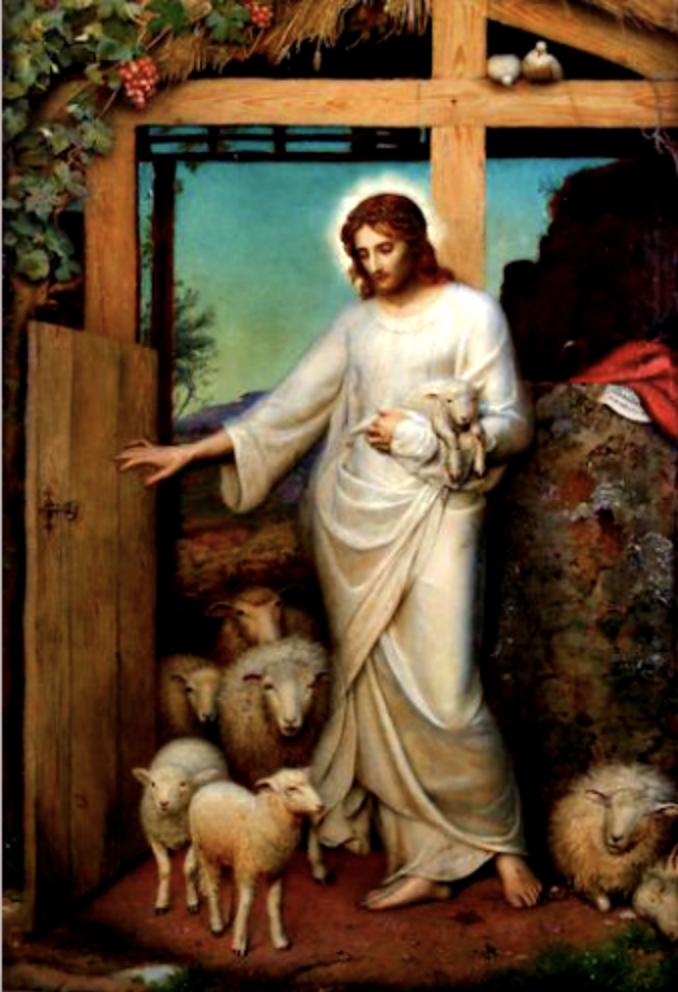One key image: It is Jesus who unlocks the gate for the sheep that respond to his “voice.”
Today in this series of articles looking at the meaning of symbolism in Christian art, we look at Sybil Parker’s 1895 painting “The Door of the Fold.”
Christ as the Good Shepherd is one of the most endearing and abiding images in Catholic faith and tradition. This theme has also featured in a variety of art forms throughout history. In fact the earliest depictions of Christ can be traced to the catacombs where a beardless young Jesus, dressed in a short white tunic, carries a lamb across His shoulders. He is the gentle Shepherd who protects, gathers and lays down His life for His sheep. Today’s painting in consideration invites us to dwell on this sacrificial and sacramental beauty of Christ.

We are at once drawn to the perfectly proportionate immaculate figure of Jesus. Dressed in an elegantly flowing white robe, His beautiful face mirrors the purity of the spotless lamb that He carries. And yet Christ here serves not only as the sacrificial Lamb of God but rather a resurrected Shepherd whose death brings fullness of life.
The painting is buffered with theological and spiritual significance. Notice the downward gaze of the gentle Shepherd. It is clearly directed towards the sheep. Christ seems to be engaged in an intimate conversation with His flock. This gesture echoes the words of the Gospel, “My sheep hear my voice … I know my sheep and they know me.”
The essence of the voice is found throughout the Bible, especially, as one may recall, during the Baptism of Jesus as well as during His transfiguration. It is the voice that calls the sheep by name and leads them out. It is through the voice that the sheep recognize the Master and belong to Him and it is the voice that speaks to the heart of the sheep; the sheep who care to listen to Him. Thus this “voice” represents the relationship that the sheep share with the Shepherd. The sheep, dim-witted as they are, yet respond to the voice of only the Shepherd. They call us to do the same in the storm of a cacophony of voices.
The next function of the Good Shepherd is illustrated in the painting by the placement of the figure of Christ. Observe carefully that it is Jesus who unlocks the gate from the outside. He leads the sheep far beyond the desert waste and the scorching sun into greener pastures and restful waters. While willingly obliging to be the doorkeeper, Jesus also assures us that He is the Gate Himself. He further adds, “Those who come in by me will be saved.”
As the sheep lie down to rest in blissful comfort, almost all of them meet the viewer’s gaze. The painting, they bleat, has more to say.
Alluring indeed is the sacrificial and sacramental component of this canvas. Behold the pair of turtledoves perched on the attic of the shed. The last time we heard about them was during the Presentation of our Lord in the Temple. Two turtledoves were offered by Christ’s parents, in accordance to the law of consecration of the first born as found in Exodus 13:1-2: The Lord said to Moses: “Dedicate all the first born males to me and every first born male animal belongs to me.” Thus the twoturtle doves were offered in place of Christ, the first born of Mary.
But this sacrifice was soon to be replaced by the ultimate sacrifice of Christ Himself; a sacrifice that won salvation and redemption. Notice how beautifully the horizontal and the vertical wooden beams intersect to form the Cross. It dwells in the shadows of Christ whose delicate locks of hair are pierced with the crown of thorns. To His left are strewn the symbols of His Passion: the rock to signify Golgotha, the Titulus Crucis, the blood-red robe and the Shepherd’s staff.
The sacrificial love of the cross transforms into a sacrament that is celebrated by the Church to this very day. Notice the bulbous grape clusters and the sheaves of dangling wheat. They epitomize the Sacrament of the Eucharist, which is the door of the fold, the door who is Christ Himself, the door that leads us to salvation.
This article was published in cooperation with Indian Catholic Matters.








